Financial Accounting Concepts & History
VerifiedAdded on 2020/02/19
|15
|3179
|132
AI Summary
This assignment delves into the foundations of financial accounting. Students are tasked with analyzing various scholarly articles that cover historical developments, conceptual frameworks, and contemporary challenges in accounting. Key themes include the evolution of accounting standards, the role of professional organizations, and the influence of interpretive research methods on accounting practices.
Contribute Materials
Your contribution can guide someone’s learning journey. Share your
documents today.
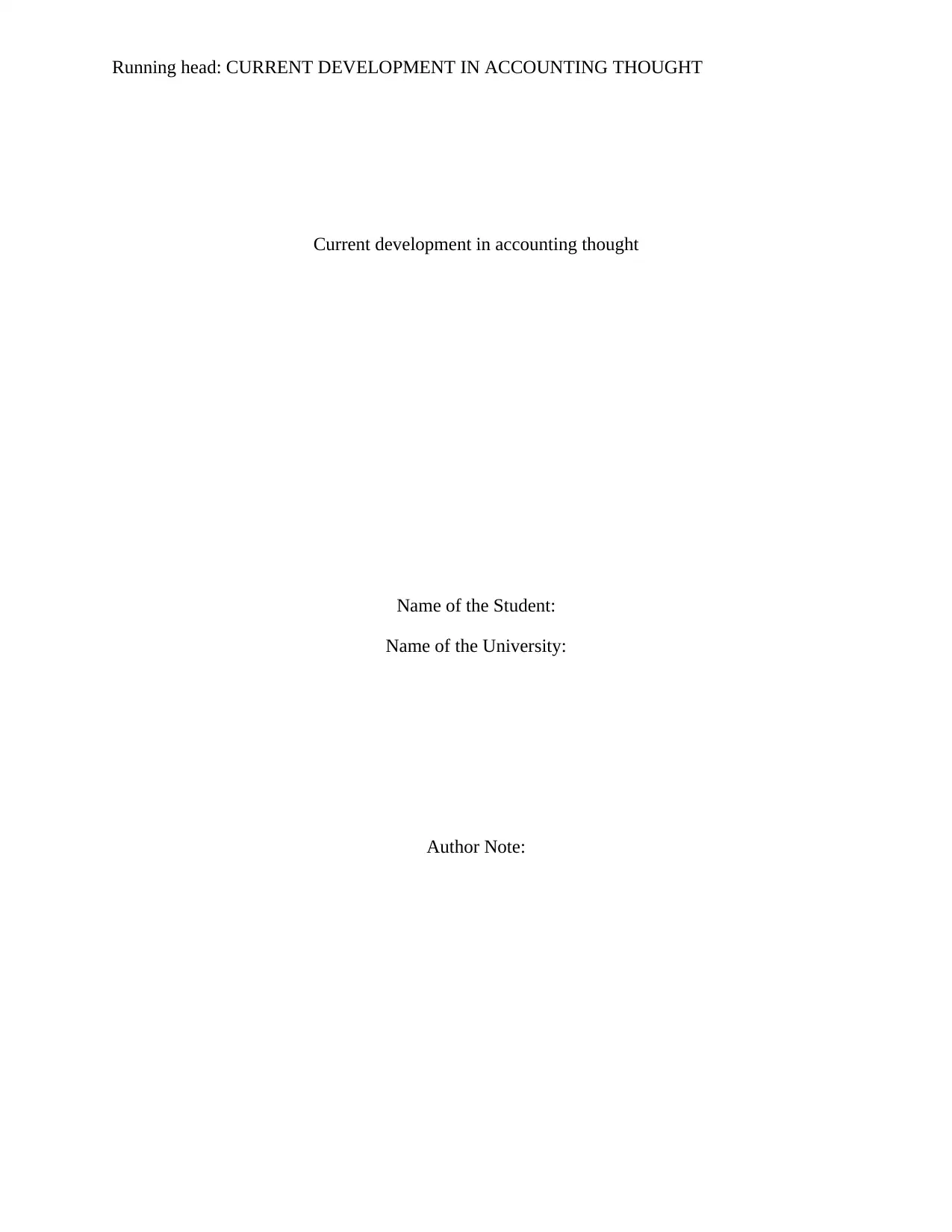
Running head: CURRENT DEVELOPMENT IN ACCOUNTING THOUGHT
Current development in accounting thought
Name of the Student:
Name of the University:
Author Note:
Current development in accounting thought
Name of the Student:
Name of the University:
Author Note:
Secure Best Marks with AI Grader
Need help grading? Try our AI Grader for instant feedback on your assignments.
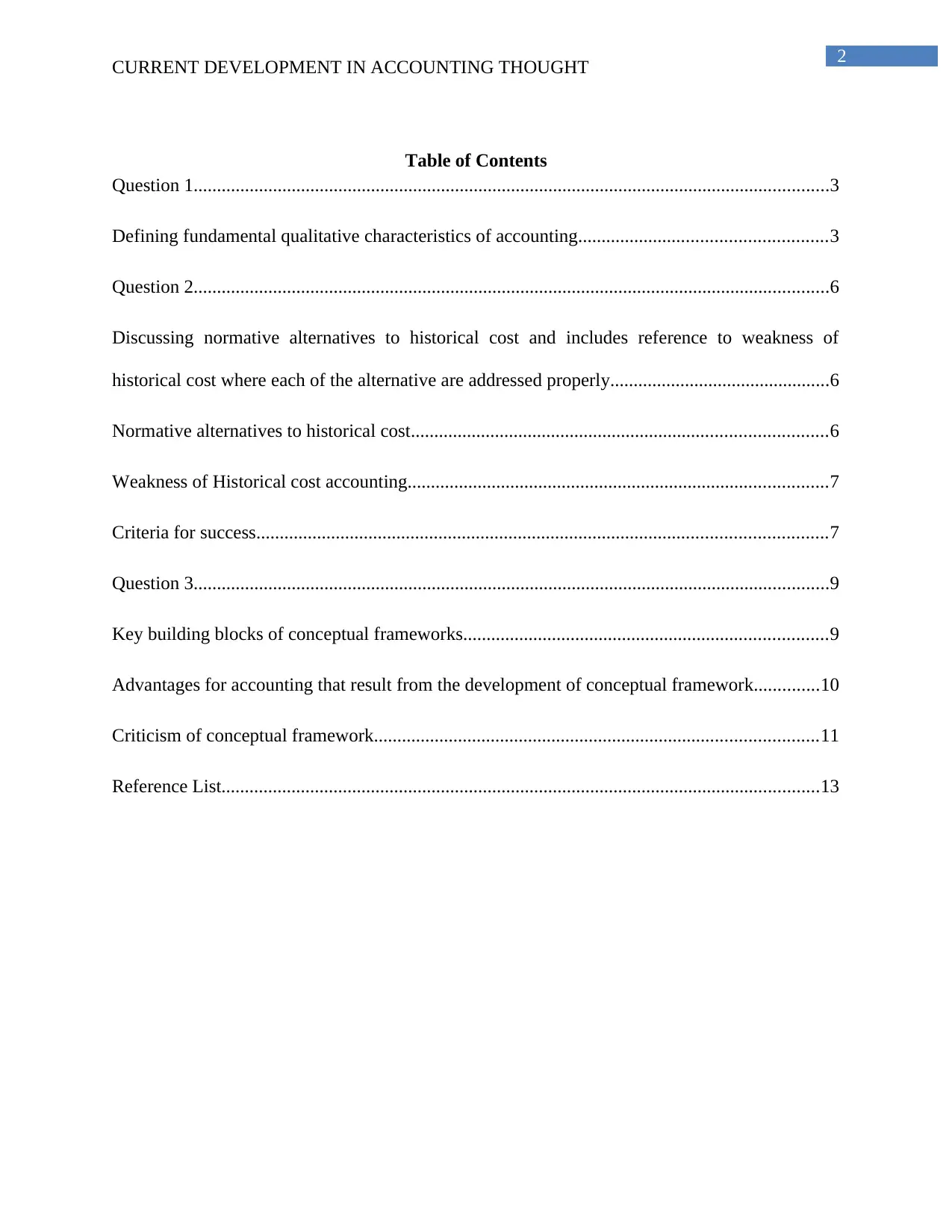
2
CURRENT DEVELOPMENT IN ACCOUNTING THOUGHT
Table of Contents
Question 1........................................................................................................................................3
Defining fundamental qualitative characteristics of accounting.....................................................3
Question 2........................................................................................................................................6
Discussing normative alternatives to historical cost and includes reference to weakness of
historical cost where each of the alternative are addressed properly...............................................6
Normative alternatives to historical cost.........................................................................................6
Weakness of Historical cost accounting..........................................................................................7
Criteria for success..........................................................................................................................7
Question 3........................................................................................................................................9
Key building blocks of conceptual frameworks..............................................................................9
Advantages for accounting that result from the development of conceptual framework..............10
Criticism of conceptual framework...............................................................................................11
Reference List................................................................................................................................13
CURRENT DEVELOPMENT IN ACCOUNTING THOUGHT
Table of Contents
Question 1........................................................................................................................................3
Defining fundamental qualitative characteristics of accounting.....................................................3
Question 2........................................................................................................................................6
Discussing normative alternatives to historical cost and includes reference to weakness of
historical cost where each of the alternative are addressed properly...............................................6
Normative alternatives to historical cost.........................................................................................6
Weakness of Historical cost accounting..........................................................................................7
Criteria for success..........................................................................................................................7
Question 3........................................................................................................................................9
Key building blocks of conceptual frameworks..............................................................................9
Advantages for accounting that result from the development of conceptual framework..............10
Criticism of conceptual framework...............................................................................................11
Reference List................................................................................................................................13
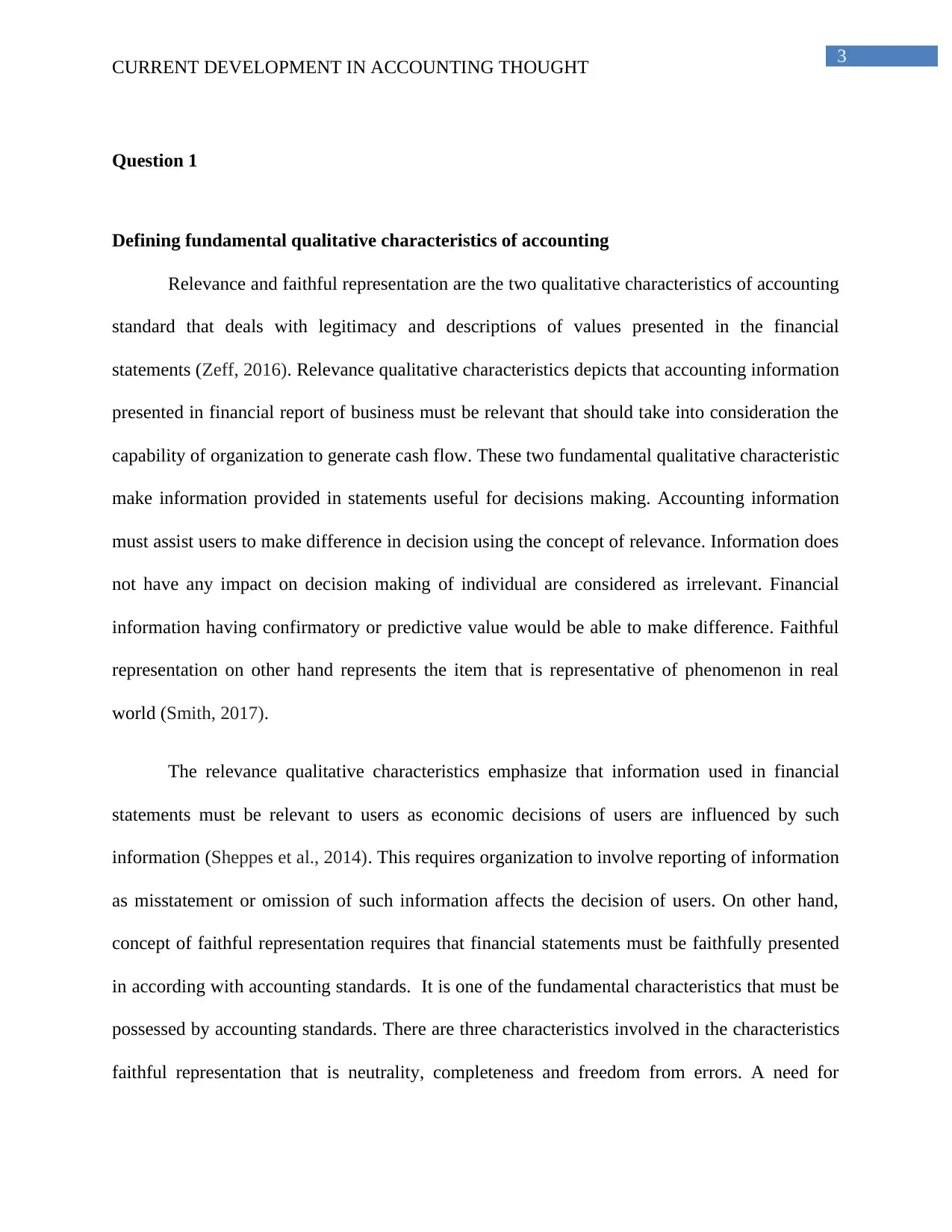
3
CURRENT DEVELOPMENT IN ACCOUNTING THOUGHT
Question 1
Defining fundamental qualitative characteristics of accounting
Relevance and faithful representation are the two qualitative characteristics of accounting
standard that deals with legitimacy and descriptions of values presented in the financial
statements (Zeff, 2016). Relevance qualitative characteristics depicts that accounting information
presented in financial report of business must be relevant that should take into consideration the
capability of organization to generate cash flow. These two fundamental qualitative characteristic
make information provided in statements useful for decisions making. Accounting information
must assist users to make difference in decision using the concept of relevance. Information does
not have any impact on decision making of individual are considered as irrelevant. Financial
information having confirmatory or predictive value would be able to make difference. Faithful
representation on other hand represents the item that is representative of phenomenon in real
world (Smith, 2017).
The relevance qualitative characteristics emphasize that information used in financial
statements must be relevant to users as economic decisions of users are influenced by such
information (Sheppes et al., 2014). This requires organization to involve reporting of information
as misstatement or omission of such information affects the decision of users. On other hand,
concept of faithful representation requires that financial statements must be faithfully presented
in according with accounting standards. It is one of the fundamental characteristics that must be
possessed by accounting standards. There are three characteristics involved in the characteristics
faithful representation that is neutrality, completeness and freedom from errors. A need for
CURRENT DEVELOPMENT IN ACCOUNTING THOUGHT
Question 1
Defining fundamental qualitative characteristics of accounting
Relevance and faithful representation are the two qualitative characteristics of accounting
standard that deals with legitimacy and descriptions of values presented in the financial
statements (Zeff, 2016). Relevance qualitative characteristics depicts that accounting information
presented in financial report of business must be relevant that should take into consideration the
capability of organization to generate cash flow. These two fundamental qualitative characteristic
make information provided in statements useful for decisions making. Accounting information
must assist users to make difference in decision using the concept of relevance. Information does
not have any impact on decision making of individual are considered as irrelevant. Financial
information having confirmatory or predictive value would be able to make difference. Faithful
representation on other hand represents the item that is representative of phenomenon in real
world (Smith, 2017).
The relevance qualitative characteristics emphasize that information used in financial
statements must be relevant to users as economic decisions of users are influenced by such
information (Sheppes et al., 2014). This requires organization to involve reporting of information
as misstatement or omission of such information affects the decision of users. On other hand,
concept of faithful representation requires that financial statements must be faithfully presented
in according with accounting standards. It is one of the fundamental characteristics that must be
possessed by accounting standards. There are three characteristics involved in the characteristics
faithful representation that is neutrality, completeness and freedom from errors. A need for
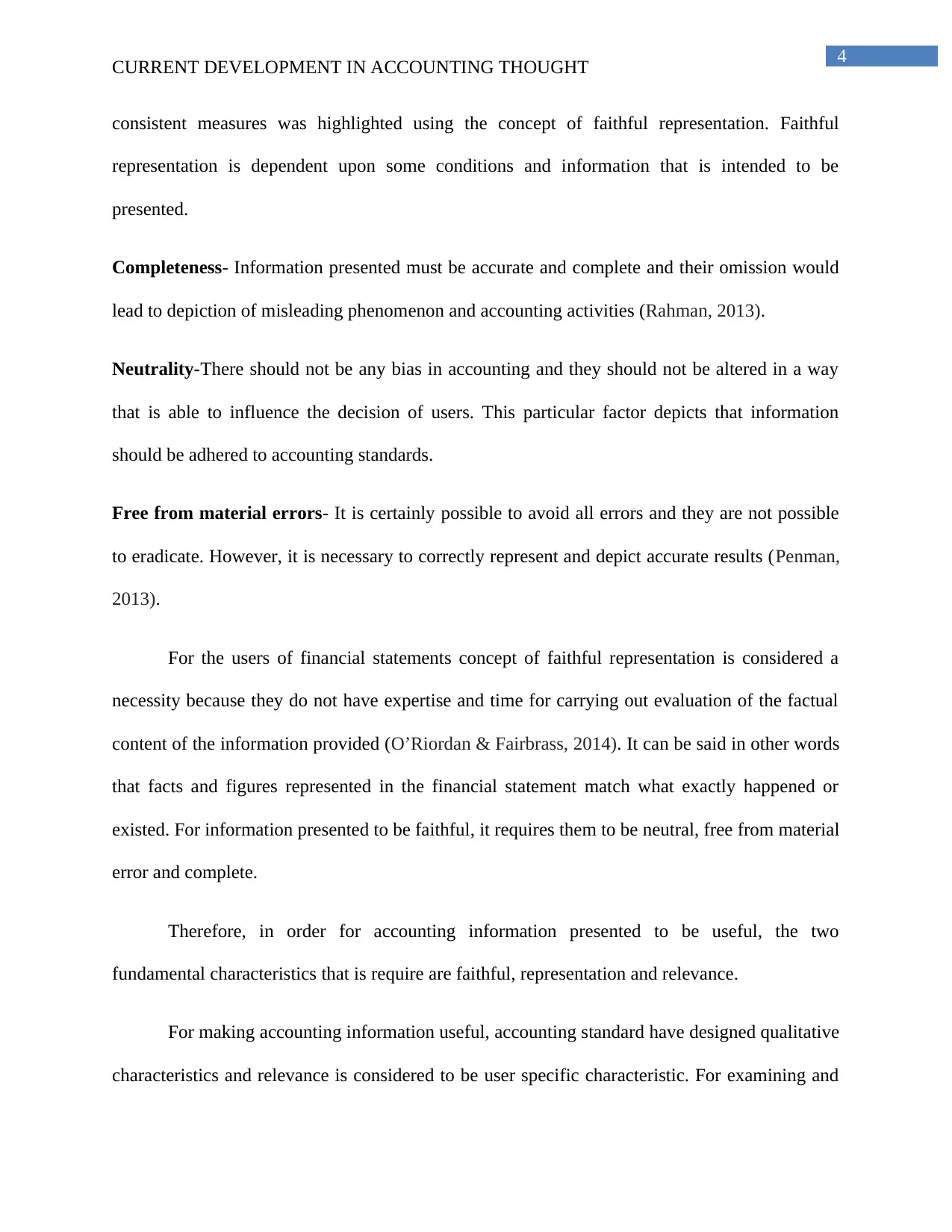
4
CURRENT DEVELOPMENT IN ACCOUNTING THOUGHT
consistent measures was highlighted using the concept of faithful representation. Faithful
representation is dependent upon some conditions and information that is intended to be
presented.
Completeness- Information presented must be accurate and complete and their omission would
lead to depiction of misleading phenomenon and accounting activities (Rahman, 2013).
Neutrality-There should not be any bias in accounting and they should not be altered in a way
that is able to influence the decision of users. This particular factor depicts that information
should be adhered to accounting standards.
Free from material errors- It is certainly possible to avoid all errors and they are not possible
to eradicate. However, it is necessary to correctly represent and depict accurate results (Penman,
2013).
For the users of financial statements concept of faithful representation is considered a
necessity because they do not have expertise and time for carrying out evaluation of the factual
content of the information provided (O’Riordan & Fairbrass, 2014). It can be said in other words
that facts and figures represented in the financial statement match what exactly happened or
existed. For information presented to be faithful, it requires them to be neutral, free from material
error and complete.
Therefore, in order for accounting information presented to be useful, the two
fundamental characteristics that is require are faithful, representation and relevance.
For making accounting information useful, accounting standard have designed qualitative
characteristics and relevance is considered to be user specific characteristic. For examining and
CURRENT DEVELOPMENT IN ACCOUNTING THOUGHT
consistent measures was highlighted using the concept of faithful representation. Faithful
representation is dependent upon some conditions and information that is intended to be
presented.
Completeness- Information presented must be accurate and complete and their omission would
lead to depiction of misleading phenomenon and accounting activities (Rahman, 2013).
Neutrality-There should not be any bias in accounting and they should not be altered in a way
that is able to influence the decision of users. This particular factor depicts that information
should be adhered to accounting standards.
Free from material errors- It is certainly possible to avoid all errors and they are not possible
to eradicate. However, it is necessary to correctly represent and depict accurate results (Penman,
2013).
For the users of financial statements concept of faithful representation is considered a
necessity because they do not have expertise and time for carrying out evaluation of the factual
content of the information provided (O’Riordan & Fairbrass, 2014). It can be said in other words
that facts and figures represented in the financial statement match what exactly happened or
existed. For information presented to be faithful, it requires them to be neutral, free from material
error and complete.
Therefore, in order for accounting information presented to be useful, the two
fundamental characteristics that is require are faithful, representation and relevance.
For making accounting information useful, accounting standard have designed qualitative
characteristics and relevance is considered to be user specific characteristic. For examining and
Secure Best Marks with AI Grader
Need help grading? Try our AI Grader for instant feedback on your assignments.
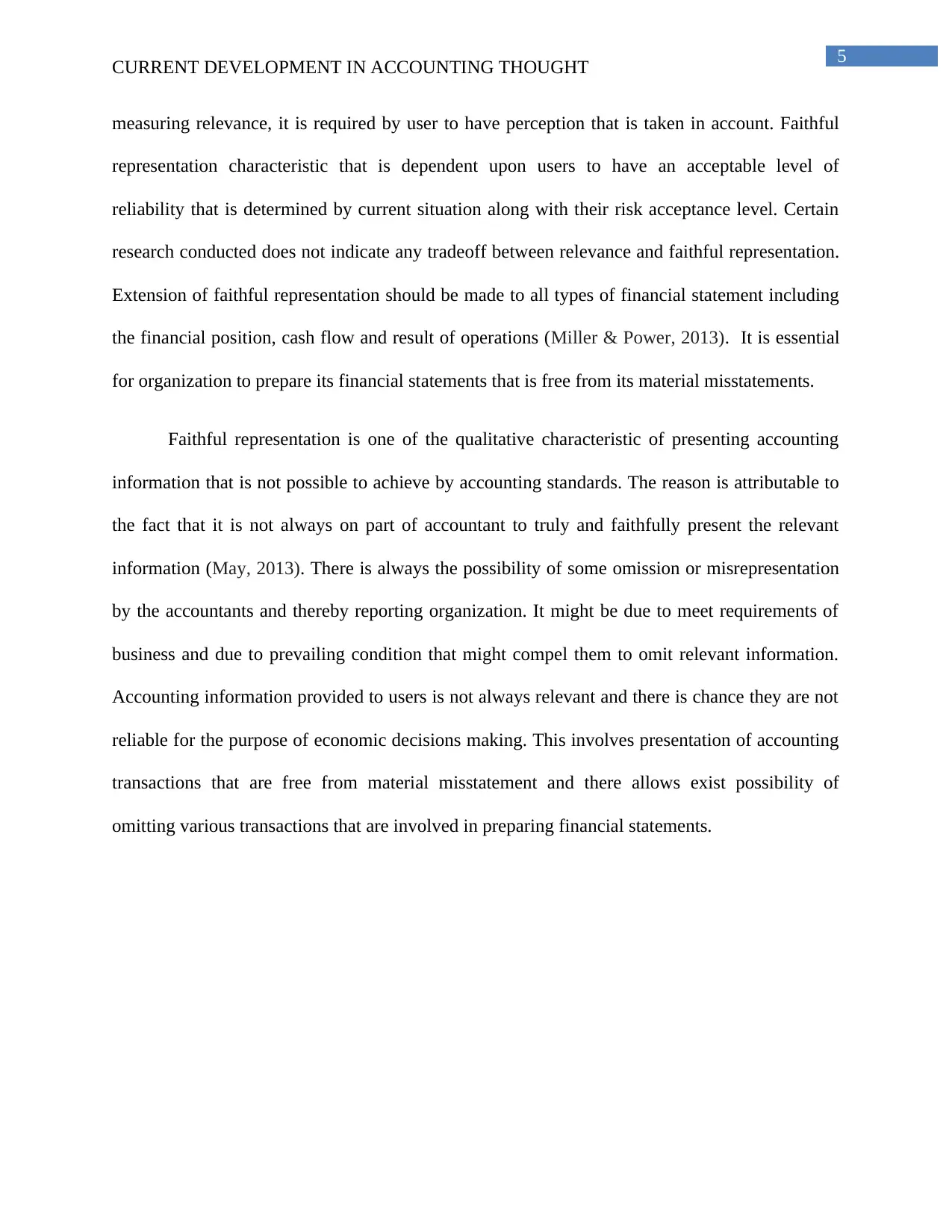
5
CURRENT DEVELOPMENT IN ACCOUNTING THOUGHT
measuring relevance, it is required by user to have perception that is taken in account. Faithful
representation characteristic that is dependent upon users to have an acceptable level of
reliability that is determined by current situation along with their risk acceptance level. Certain
research conducted does not indicate any tradeoff between relevance and faithful representation.
Extension of faithful representation should be made to all types of financial statement including
the financial position, cash flow and result of operations (Miller & Power, 2013). It is essential
for organization to prepare its financial statements that is free from its material misstatements.
Faithful representation is one of the qualitative characteristic of presenting accounting
information that is not possible to achieve by accounting standards. The reason is attributable to
the fact that it is not always on part of accountant to truly and faithfully present the relevant
information (May, 2013). There is always the possibility of some omission or misrepresentation
by the accountants and thereby reporting organization. It might be due to meet requirements of
business and due to prevailing condition that might compel them to omit relevant information.
Accounting information provided to users is not always relevant and there is chance they are not
reliable for the purpose of economic decisions making. This involves presentation of accounting
transactions that are free from material misstatement and there allows exist possibility of
omitting various transactions that are involved in preparing financial statements.
CURRENT DEVELOPMENT IN ACCOUNTING THOUGHT
measuring relevance, it is required by user to have perception that is taken in account. Faithful
representation characteristic that is dependent upon users to have an acceptable level of
reliability that is determined by current situation along with their risk acceptance level. Certain
research conducted does not indicate any tradeoff between relevance and faithful representation.
Extension of faithful representation should be made to all types of financial statement including
the financial position, cash flow and result of operations (Miller & Power, 2013). It is essential
for organization to prepare its financial statements that is free from its material misstatements.
Faithful representation is one of the qualitative characteristic of presenting accounting
information that is not possible to achieve by accounting standards. The reason is attributable to
the fact that it is not always on part of accountant to truly and faithfully present the relevant
information (May, 2013). There is always the possibility of some omission or misrepresentation
by the accountants and thereby reporting organization. It might be due to meet requirements of
business and due to prevailing condition that might compel them to omit relevant information.
Accounting information provided to users is not always relevant and there is chance they are not
reliable for the purpose of economic decisions making. This involves presentation of accounting
transactions that are free from material misstatement and there allows exist possibility of
omitting various transactions that are involved in preparing financial statements.
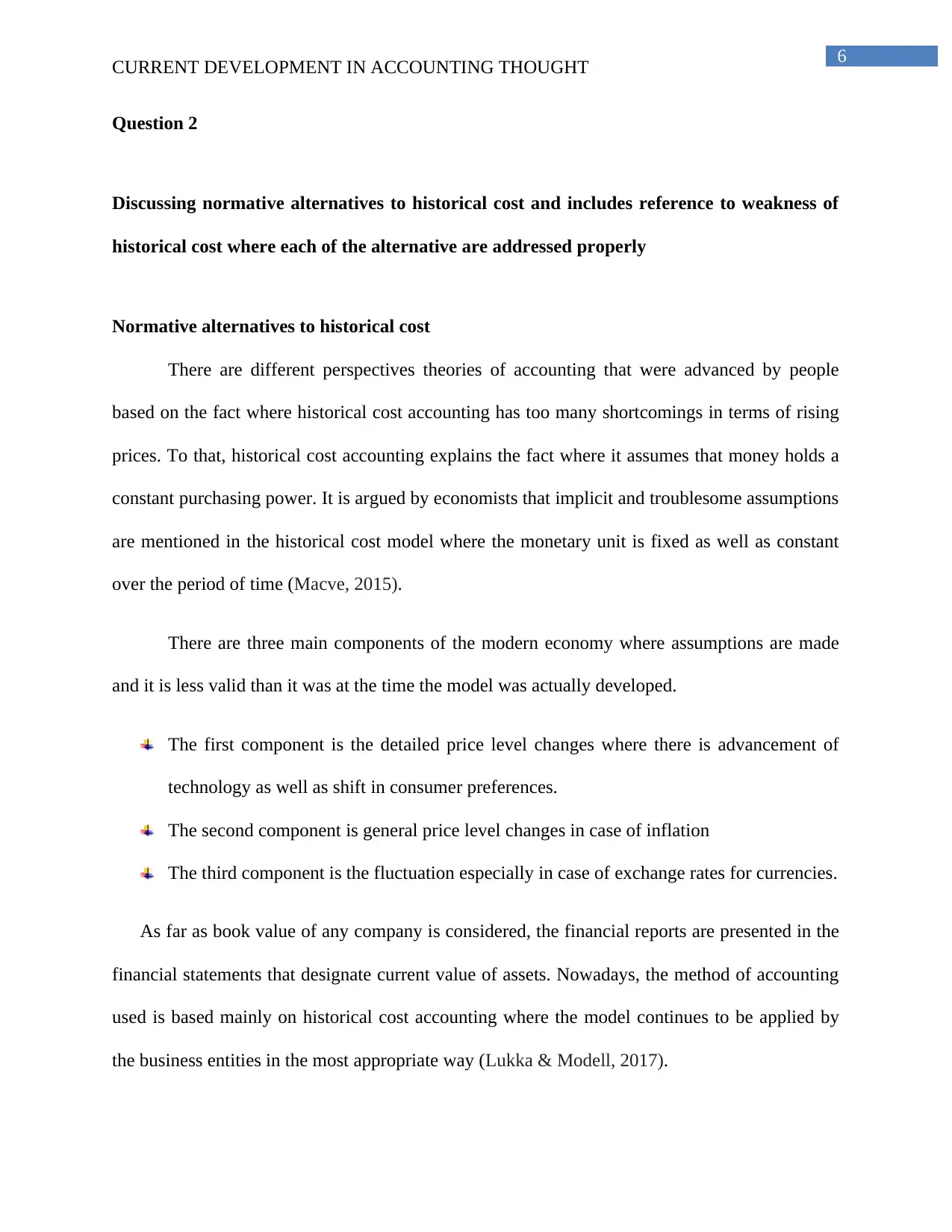
6
CURRENT DEVELOPMENT IN ACCOUNTING THOUGHT
Question 2
Discussing normative alternatives to historical cost and includes reference to weakness of
historical cost where each of the alternative are addressed properly
Normative alternatives to historical cost
There are different perspectives theories of accounting that were advanced by people
based on the fact where historical cost accounting has too many shortcomings in terms of rising
prices. To that, historical cost accounting explains the fact where it assumes that money holds a
constant purchasing power. It is argued by economists that implicit and troublesome assumptions
are mentioned in the historical cost model where the monetary unit is fixed as well as constant
over the period of time (Macve, 2015).
There are three main components of the modern economy where assumptions are made
and it is less valid than it was at the time the model was actually developed.
The first component is the detailed price level changes where there is advancement of
technology as well as shift in consumer preferences.
The second component is general price level changes in case of inflation
The third component is the fluctuation especially in case of exchange rates for currencies.
As far as book value of any company is considered, the financial reports are presented in the
financial statements that designate current value of assets. Nowadays, the method of accounting
used is based mainly on historical cost accounting where the model continues to be applied by
the business entities in the most appropriate way (Lukka & Modell, 2017).
CURRENT DEVELOPMENT IN ACCOUNTING THOUGHT
Question 2
Discussing normative alternatives to historical cost and includes reference to weakness of
historical cost where each of the alternative are addressed properly
Normative alternatives to historical cost
There are different perspectives theories of accounting that were advanced by people
based on the fact where historical cost accounting has too many shortcomings in terms of rising
prices. To that, historical cost accounting explains the fact where it assumes that money holds a
constant purchasing power. It is argued by economists that implicit and troublesome assumptions
are mentioned in the historical cost model where the monetary unit is fixed as well as constant
over the period of time (Macve, 2015).
There are three main components of the modern economy where assumptions are made
and it is less valid than it was at the time the model was actually developed.
The first component is the detailed price level changes where there is advancement of
technology as well as shift in consumer preferences.
The second component is general price level changes in case of inflation
The third component is the fluctuation especially in case of exchange rates for currencies.
As far as book value of any company is considered, the financial reports are presented in the
financial statements that designate current value of assets. Nowadays, the method of accounting
used is based mainly on historical cost accounting where the model continues to be applied by
the business entities in the most appropriate way (Lukka & Modell, 2017).
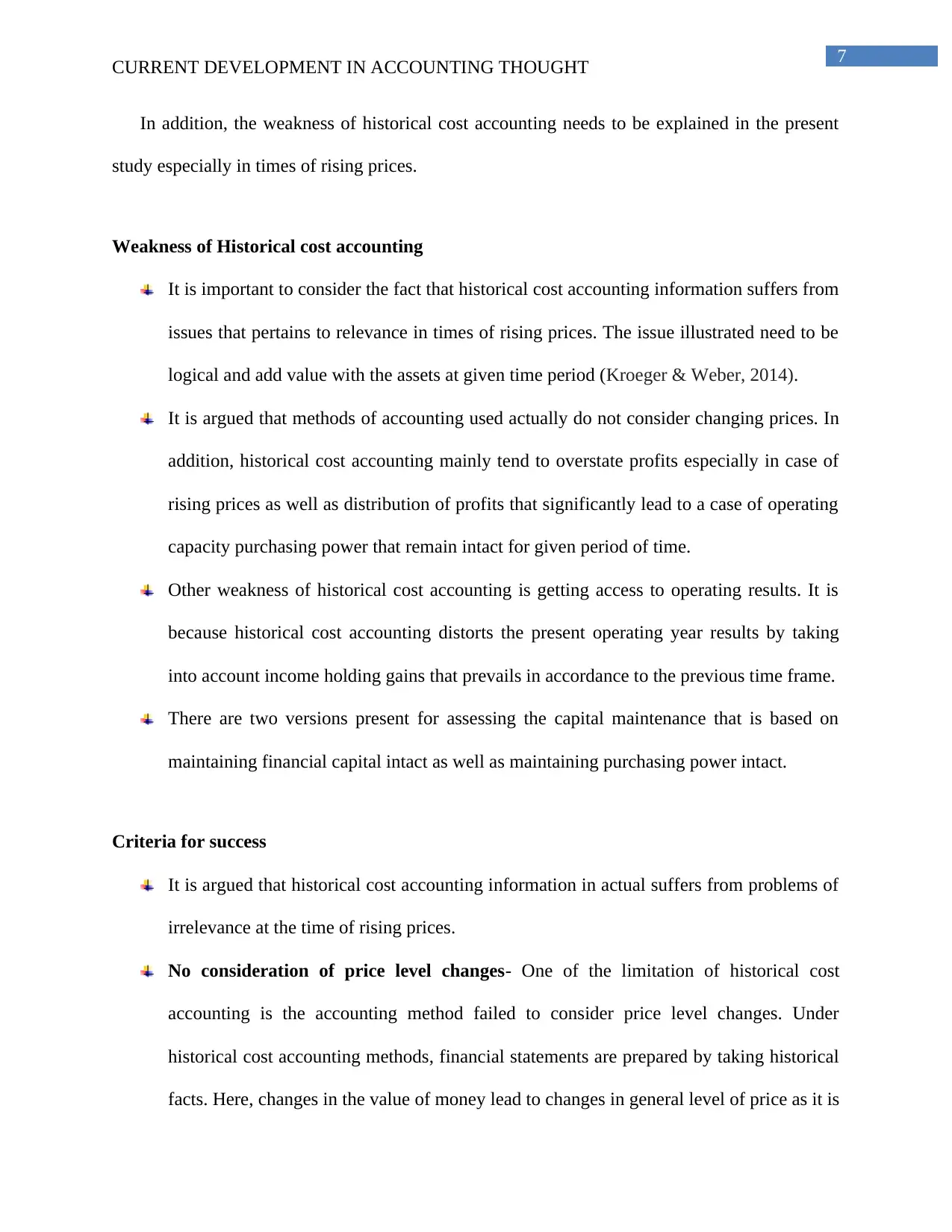
7
CURRENT DEVELOPMENT IN ACCOUNTING THOUGHT
In addition, the weakness of historical cost accounting needs to be explained in the present
study especially in times of rising prices.
Weakness of Historical cost accounting
It is important to consider the fact that historical cost accounting information suffers from
issues that pertains to relevance in times of rising prices. The issue illustrated need to be
logical and add value with the assets at given time period (Kroeger & Weber, 2014).
It is argued that methods of accounting used actually do not consider changing prices. In
addition, historical cost accounting mainly tend to overstate profits especially in case of
rising prices as well as distribution of profits that significantly lead to a case of operating
capacity purchasing power that remain intact for given period of time.
Other weakness of historical cost accounting is getting access to operating results. It is
because historical cost accounting distorts the present operating year results by taking
into account income holding gains that prevails in accordance to the previous time frame.
There are two versions present for assessing the capital maintenance that is based on
maintaining financial capital intact as well as maintaining purchasing power intact.
Criteria for success
It is argued that historical cost accounting information in actual suffers from problems of
irrelevance at the time of rising prices.
No consideration of price level changes- One of the limitation of historical cost
accounting is the accounting method failed to consider price level changes. Under
historical cost accounting methods, financial statements are prepared by taking historical
facts. Here, changes in the value of money lead to changes in general level of price as it is
CURRENT DEVELOPMENT IN ACCOUNTING THOUGHT
In addition, the weakness of historical cost accounting needs to be explained in the present
study especially in times of rising prices.
Weakness of Historical cost accounting
It is important to consider the fact that historical cost accounting information suffers from
issues that pertains to relevance in times of rising prices. The issue illustrated need to be
logical and add value with the assets at given time period (Kroeger & Weber, 2014).
It is argued that methods of accounting used actually do not consider changing prices. In
addition, historical cost accounting mainly tend to overstate profits especially in case of
rising prices as well as distribution of profits that significantly lead to a case of operating
capacity purchasing power that remain intact for given period of time.
Other weakness of historical cost accounting is getting access to operating results. It is
because historical cost accounting distorts the present operating year results by taking
into account income holding gains that prevails in accordance to the previous time frame.
There are two versions present for assessing the capital maintenance that is based on
maintaining financial capital intact as well as maintaining purchasing power intact.
Criteria for success
It is argued that historical cost accounting information in actual suffers from problems of
irrelevance at the time of rising prices.
No consideration of price level changes- One of the limitation of historical cost
accounting is the accounting method failed to consider price level changes. Under
historical cost accounting methods, financial statements are prepared by taking historical
facts. Here, changes in the value of money lead to changes in general level of price as it is
Paraphrase This Document
Need a fresh take? Get an instant paraphrase of this document with our AI Paraphraser
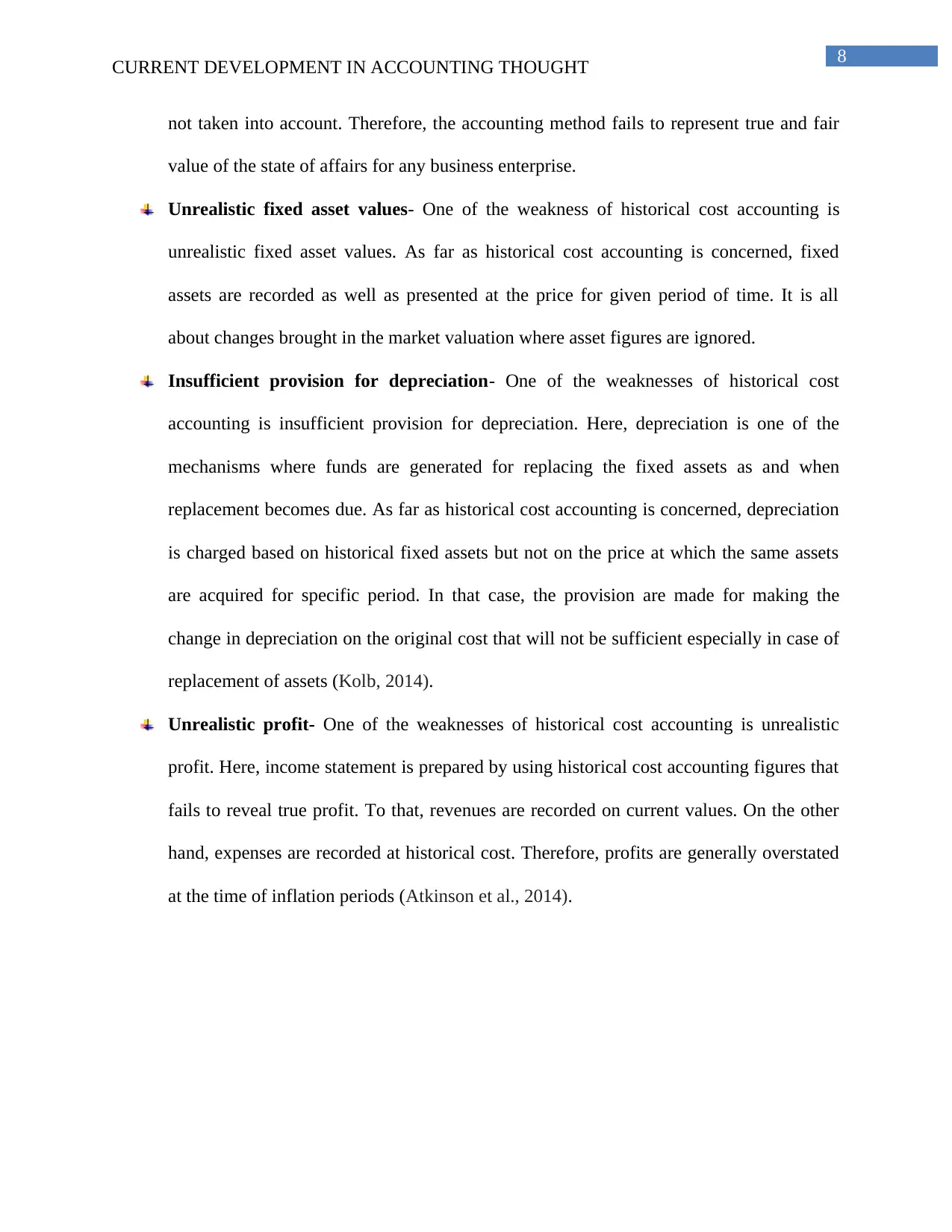
8
CURRENT DEVELOPMENT IN ACCOUNTING THOUGHT
not taken into account. Therefore, the accounting method fails to represent true and fair
value of the state of affairs for any business enterprise.
Unrealistic fixed asset values- One of the weakness of historical cost accounting is
unrealistic fixed asset values. As far as historical cost accounting is concerned, fixed
assets are recorded as well as presented at the price for given period of time. It is all
about changes brought in the market valuation where asset figures are ignored.
Insufficient provision for depreciation- One of the weaknesses of historical cost
accounting is insufficient provision for depreciation. Here, depreciation is one of the
mechanisms where funds are generated for replacing the fixed assets as and when
replacement becomes due. As far as historical cost accounting is concerned, depreciation
is charged based on historical fixed assets but not on the price at which the same assets
are acquired for specific period. In that case, the provision are made for making the
change in depreciation on the original cost that will not be sufficient especially in case of
replacement of assets (Kolb, 2014).
Unrealistic profit- One of the weaknesses of historical cost accounting is unrealistic
profit. Here, income statement is prepared by using historical cost accounting figures that
fails to reveal true profit. To that, revenues are recorded on current values. On the other
hand, expenses are recorded at historical cost. Therefore, profits are generally overstated
at the time of inflation periods (Atkinson et al., 2014).
CURRENT DEVELOPMENT IN ACCOUNTING THOUGHT
not taken into account. Therefore, the accounting method fails to represent true and fair
value of the state of affairs for any business enterprise.
Unrealistic fixed asset values- One of the weakness of historical cost accounting is
unrealistic fixed asset values. As far as historical cost accounting is concerned, fixed
assets are recorded as well as presented at the price for given period of time. It is all
about changes brought in the market valuation where asset figures are ignored.
Insufficient provision for depreciation- One of the weaknesses of historical cost
accounting is insufficient provision for depreciation. Here, depreciation is one of the
mechanisms where funds are generated for replacing the fixed assets as and when
replacement becomes due. As far as historical cost accounting is concerned, depreciation
is charged based on historical fixed assets but not on the price at which the same assets
are acquired for specific period. In that case, the provision are made for making the
change in depreciation on the original cost that will not be sufficient especially in case of
replacement of assets (Kolb, 2014).
Unrealistic profit- One of the weaknesses of historical cost accounting is unrealistic
profit. Here, income statement is prepared by using historical cost accounting figures that
fails to reveal true profit. To that, revenues are recorded on current values. On the other
hand, expenses are recorded at historical cost. Therefore, profits are generally overstated
at the time of inflation periods (Atkinson et al., 2014).
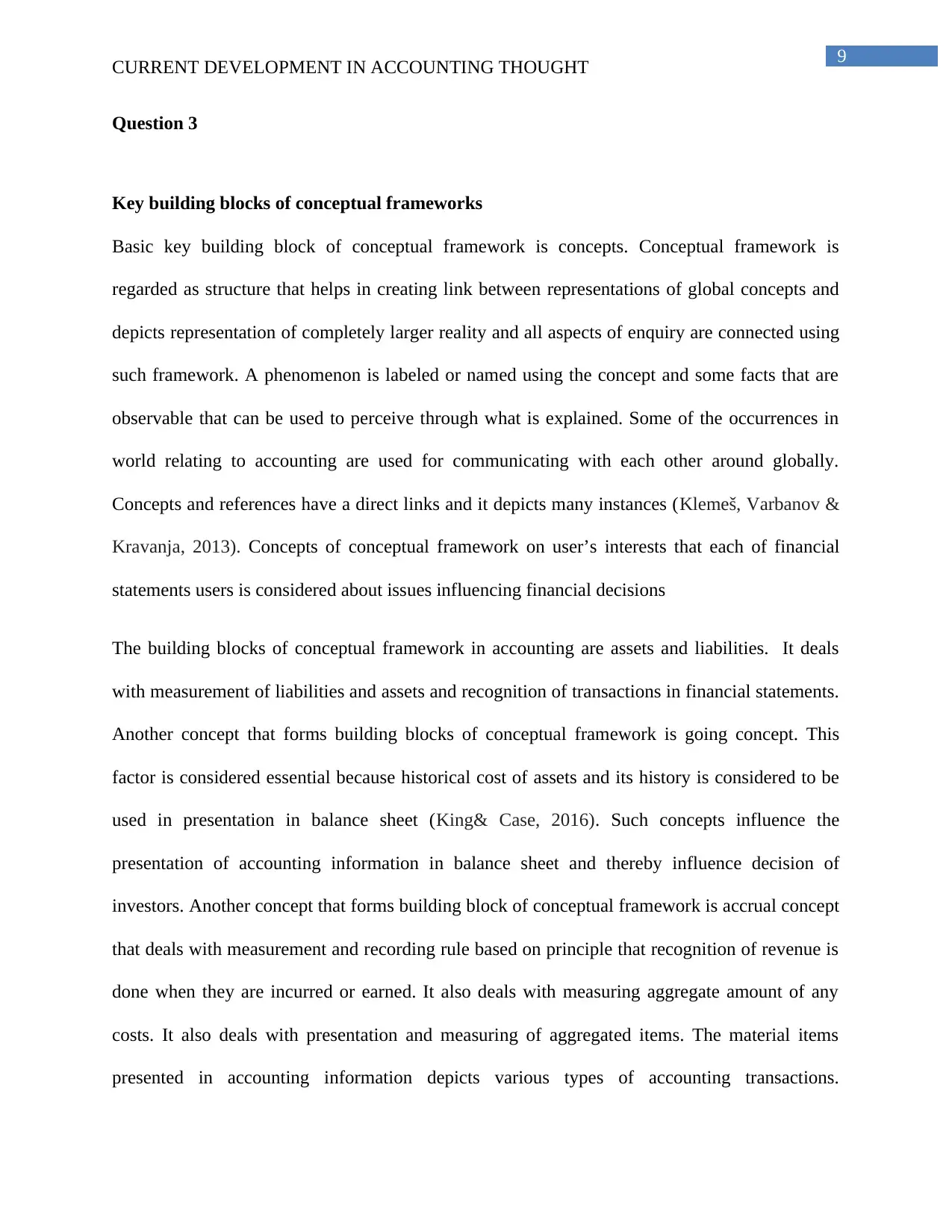
9
CURRENT DEVELOPMENT IN ACCOUNTING THOUGHT
Question 3
Key building blocks of conceptual frameworks
Basic key building block of conceptual framework is concepts. Conceptual framework is
regarded as structure that helps in creating link between representations of global concepts and
depicts representation of completely larger reality and all aspects of enquiry are connected using
such framework. A phenomenon is labeled or named using the concept and some facts that are
observable that can be used to perceive through what is explained. Some of the occurrences in
world relating to accounting are used for communicating with each other around globally.
Concepts and references have a direct links and it depicts many instances (Klemeš, Varbanov &
Kravanja, 2013). Concepts of conceptual framework on user’s interests that each of financial
statements users is considered about issues influencing financial decisions
The building blocks of conceptual framework in accounting are assets and liabilities. It deals
with measurement of liabilities and assets and recognition of transactions in financial statements.
Another concept that forms building blocks of conceptual framework is going concept. This
factor is considered essential because historical cost of assets and its history is considered to be
used in presentation in balance sheet (King& Case, 2016). Such concepts influence the
presentation of accounting information in balance sheet and thereby influence decision of
investors. Another concept that forms building block of conceptual framework is accrual concept
that deals with measurement and recording rule based on principle that recognition of revenue is
done when they are incurred or earned. It also deals with measuring aggregate amount of any
costs. It also deals with presentation and measuring of aggregated items. The material items
presented in accounting information depicts various types of accounting transactions.
CURRENT DEVELOPMENT IN ACCOUNTING THOUGHT
Question 3
Key building blocks of conceptual frameworks
Basic key building block of conceptual framework is concepts. Conceptual framework is
regarded as structure that helps in creating link between representations of global concepts and
depicts representation of completely larger reality and all aspects of enquiry are connected using
such framework. A phenomenon is labeled or named using the concept and some facts that are
observable that can be used to perceive through what is explained. Some of the occurrences in
world relating to accounting are used for communicating with each other around globally.
Concepts and references have a direct links and it depicts many instances (Klemeš, Varbanov &
Kravanja, 2013). Concepts of conceptual framework on user’s interests that each of financial
statements users is considered about issues influencing financial decisions
The building blocks of conceptual framework in accounting are assets and liabilities. It deals
with measurement of liabilities and assets and recognition of transactions in financial statements.
Another concept that forms building blocks of conceptual framework is going concept. This
factor is considered essential because historical cost of assets and its history is considered to be
used in presentation in balance sheet (King& Case, 2016). Such concepts influence the
presentation of accounting information in balance sheet and thereby influence decision of
investors. Another concept that forms building block of conceptual framework is accrual concept
that deals with measurement and recording rule based on principle that recognition of revenue is
done when they are incurred or earned. It also deals with measuring aggregate amount of any
costs. It also deals with presentation and measuring of aggregated items. The material items
presented in accounting information depicts various types of accounting transactions.
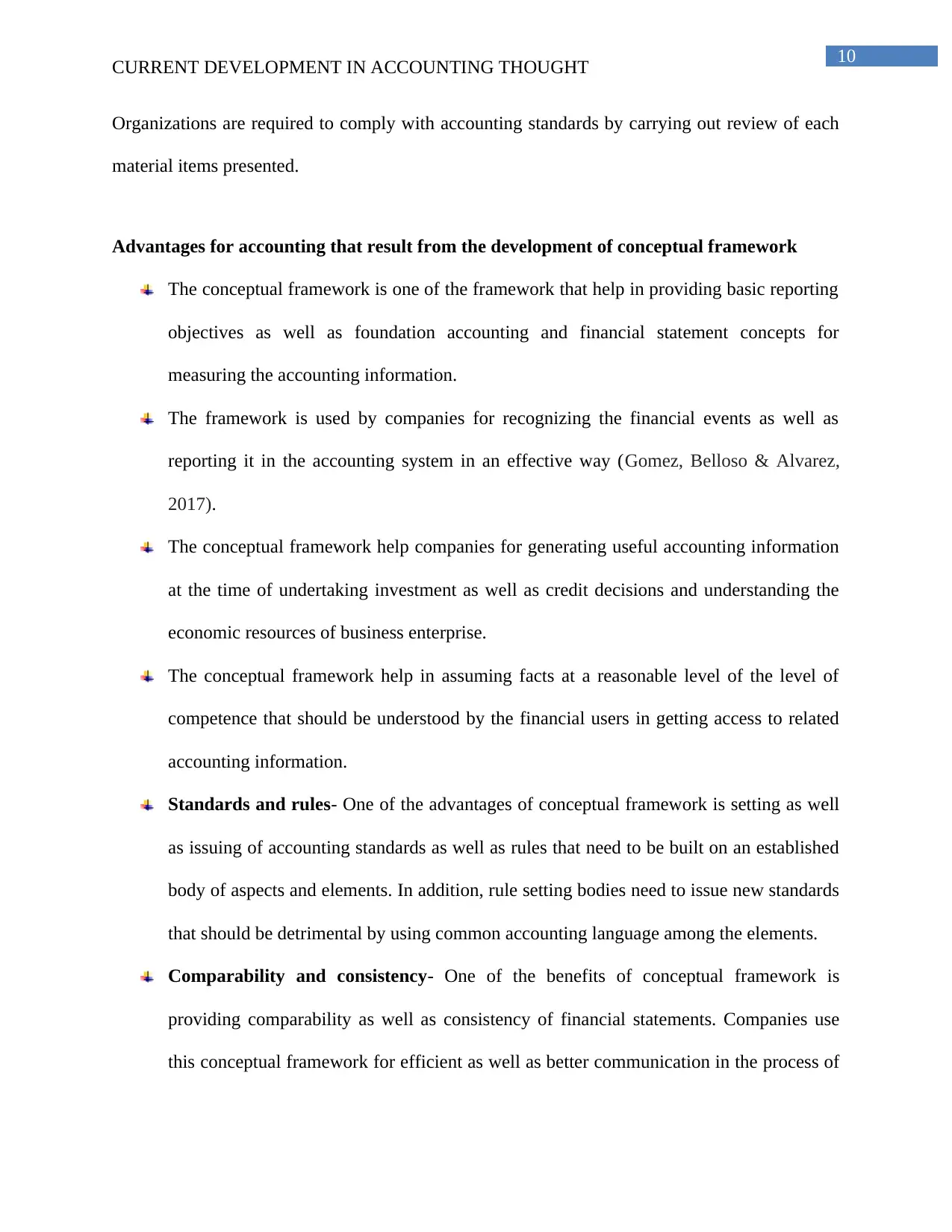
10
CURRENT DEVELOPMENT IN ACCOUNTING THOUGHT
Organizations are required to comply with accounting standards by carrying out review of each
material items presented.
Advantages for accounting that result from the development of conceptual framework
The conceptual framework is one of the framework that help in providing basic reporting
objectives as well as foundation accounting and financial statement concepts for
measuring the accounting information.
The framework is used by companies for recognizing the financial events as well as
reporting it in the accounting system in an effective way (Gomez, Belloso & Alvarez,
2017).
The conceptual framework help companies for generating useful accounting information
at the time of undertaking investment as well as credit decisions and understanding the
economic resources of business enterprise.
The conceptual framework help in assuming facts at a reasonable level of the level of
competence that should be understood by the financial users in getting access to related
accounting information.
Standards and rules- One of the advantages of conceptual framework is setting as well
as issuing of accounting standards as well as rules that need to be built on an established
body of aspects and elements. In addition, rule setting bodies need to issue new standards
that should be detrimental by using common accounting language among the elements.
Comparability and consistency- One of the benefits of conceptual framework is
providing comparability as well as consistency of financial statements. Companies use
this conceptual framework for efficient as well as better communication in the process of
CURRENT DEVELOPMENT IN ACCOUNTING THOUGHT
Organizations are required to comply with accounting standards by carrying out review of each
material items presented.
Advantages for accounting that result from the development of conceptual framework
The conceptual framework is one of the framework that help in providing basic reporting
objectives as well as foundation accounting and financial statement concepts for
measuring the accounting information.
The framework is used by companies for recognizing the financial events as well as
reporting it in the accounting system in an effective way (Gomez, Belloso & Alvarez,
2017).
The conceptual framework help companies for generating useful accounting information
at the time of undertaking investment as well as credit decisions and understanding the
economic resources of business enterprise.
The conceptual framework help in assuming facts at a reasonable level of the level of
competence that should be understood by the financial users in getting access to related
accounting information.
Standards and rules- One of the advantages of conceptual framework is setting as well
as issuing of accounting standards as well as rules that need to be built on an established
body of aspects and elements. In addition, rule setting bodies need to issue new standards
that should be detrimental by using common accounting language among the elements.
Comparability and consistency- One of the benefits of conceptual framework is
providing comparability as well as consistency of financial statements. Companies use
this conceptual framework for efficient as well as better communication in the process of
Secure Best Marks with AI Grader
Need help grading? Try our AI Grader for instant feedback on your assignments.
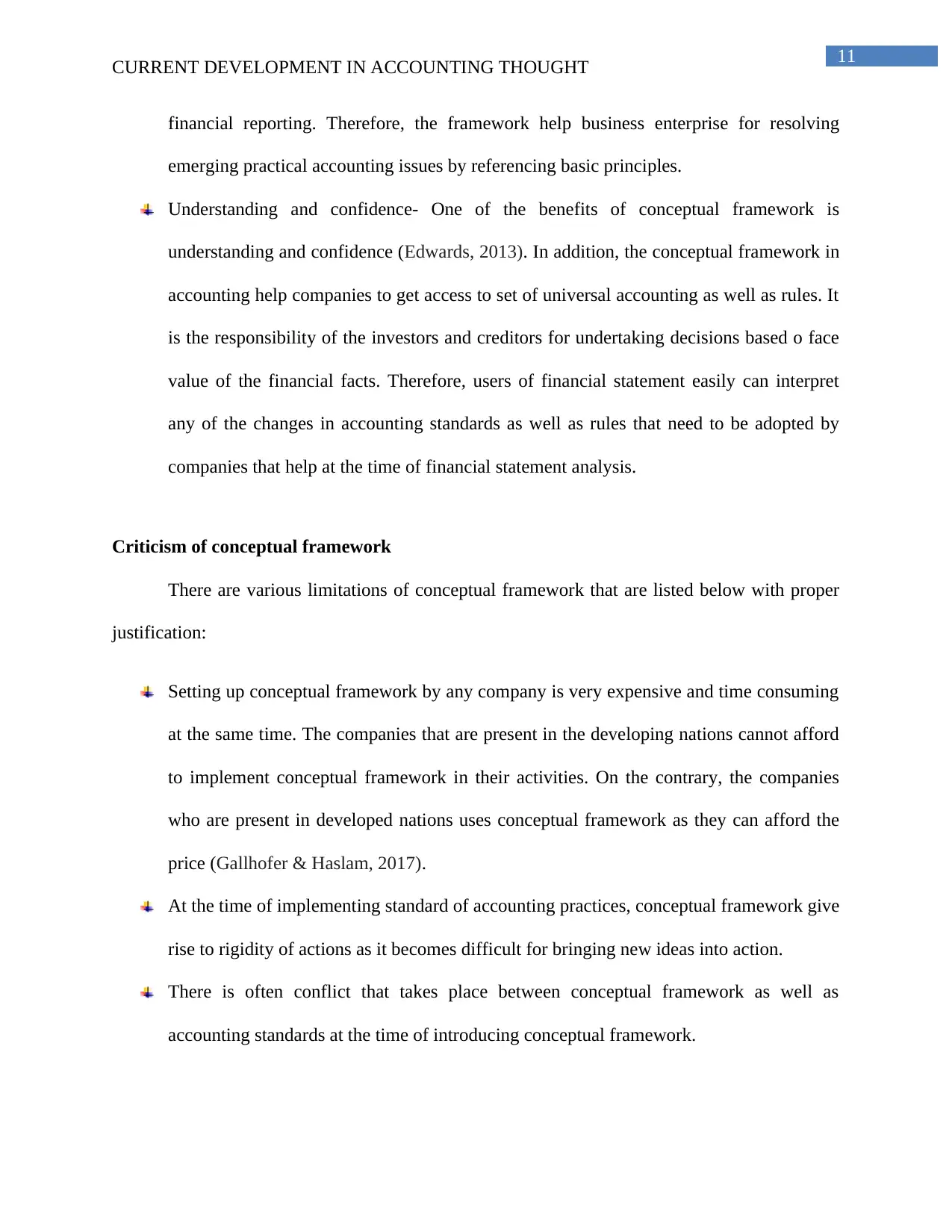
11
CURRENT DEVELOPMENT IN ACCOUNTING THOUGHT
financial reporting. Therefore, the framework help business enterprise for resolving
emerging practical accounting issues by referencing basic principles.
Understanding and confidence- One of the benefits of conceptual framework is
understanding and confidence (Edwards, 2013). In addition, the conceptual framework in
accounting help companies to get access to set of universal accounting as well as rules. It
is the responsibility of the investors and creditors for undertaking decisions based o face
value of the financial facts. Therefore, users of financial statement easily can interpret
any of the changes in accounting standards as well as rules that need to be adopted by
companies that help at the time of financial statement analysis.
Criticism of conceptual framework
There are various limitations of conceptual framework that are listed below with proper
justification:
Setting up conceptual framework by any company is very expensive and time consuming
at the same time. The companies that are present in the developing nations cannot afford
to implement conceptual framework in their activities. On the contrary, the companies
who are present in developed nations uses conceptual framework as they can afford the
price (Gallhofer & Haslam, 2017).
At the time of implementing standard of accounting practices, conceptual framework give
rise to rigidity of actions as it becomes difficult for bringing new ideas into action.
There is often conflict that takes place between conceptual framework as well as
accounting standards at the time of introducing conceptual framework.
CURRENT DEVELOPMENT IN ACCOUNTING THOUGHT
financial reporting. Therefore, the framework help business enterprise for resolving
emerging practical accounting issues by referencing basic principles.
Understanding and confidence- One of the benefits of conceptual framework is
understanding and confidence (Edwards, 2013). In addition, the conceptual framework in
accounting help companies to get access to set of universal accounting as well as rules. It
is the responsibility of the investors and creditors for undertaking decisions based o face
value of the financial facts. Therefore, users of financial statement easily can interpret
any of the changes in accounting standards as well as rules that need to be adopted by
companies that help at the time of financial statement analysis.
Criticism of conceptual framework
There are various limitations of conceptual framework that are listed below with proper
justification:
Setting up conceptual framework by any company is very expensive and time consuming
at the same time. The companies that are present in the developing nations cannot afford
to implement conceptual framework in their activities. On the contrary, the companies
who are present in developed nations uses conceptual framework as they can afford the
price (Gallhofer & Haslam, 2017).
At the time of implementing standard of accounting practices, conceptual framework give
rise to rigidity of actions as it becomes difficult for bringing new ideas into action.
There is often conflict that takes place between conceptual framework as well as
accounting standards at the time of introducing conceptual framework.
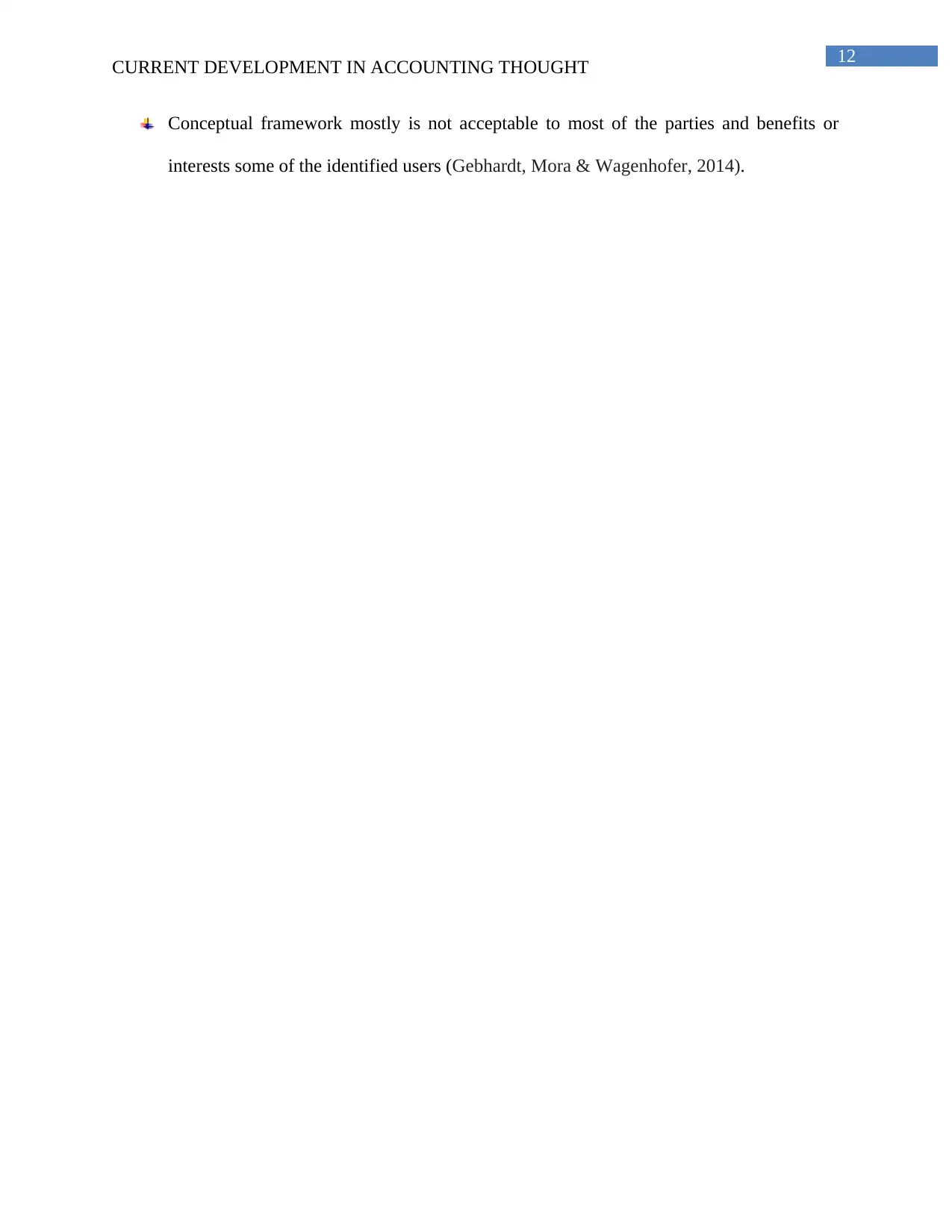
12
CURRENT DEVELOPMENT IN ACCOUNTING THOUGHT
Conceptual framework mostly is not acceptable to most of the parties and benefits or
interests some of the identified users (Gebhardt, Mora & Wagenhofer, 2014).
CURRENT DEVELOPMENT IN ACCOUNTING THOUGHT
Conceptual framework mostly is not acceptable to most of the parties and benefits or
interests some of the identified users (Gebhardt, Mora & Wagenhofer, 2014).
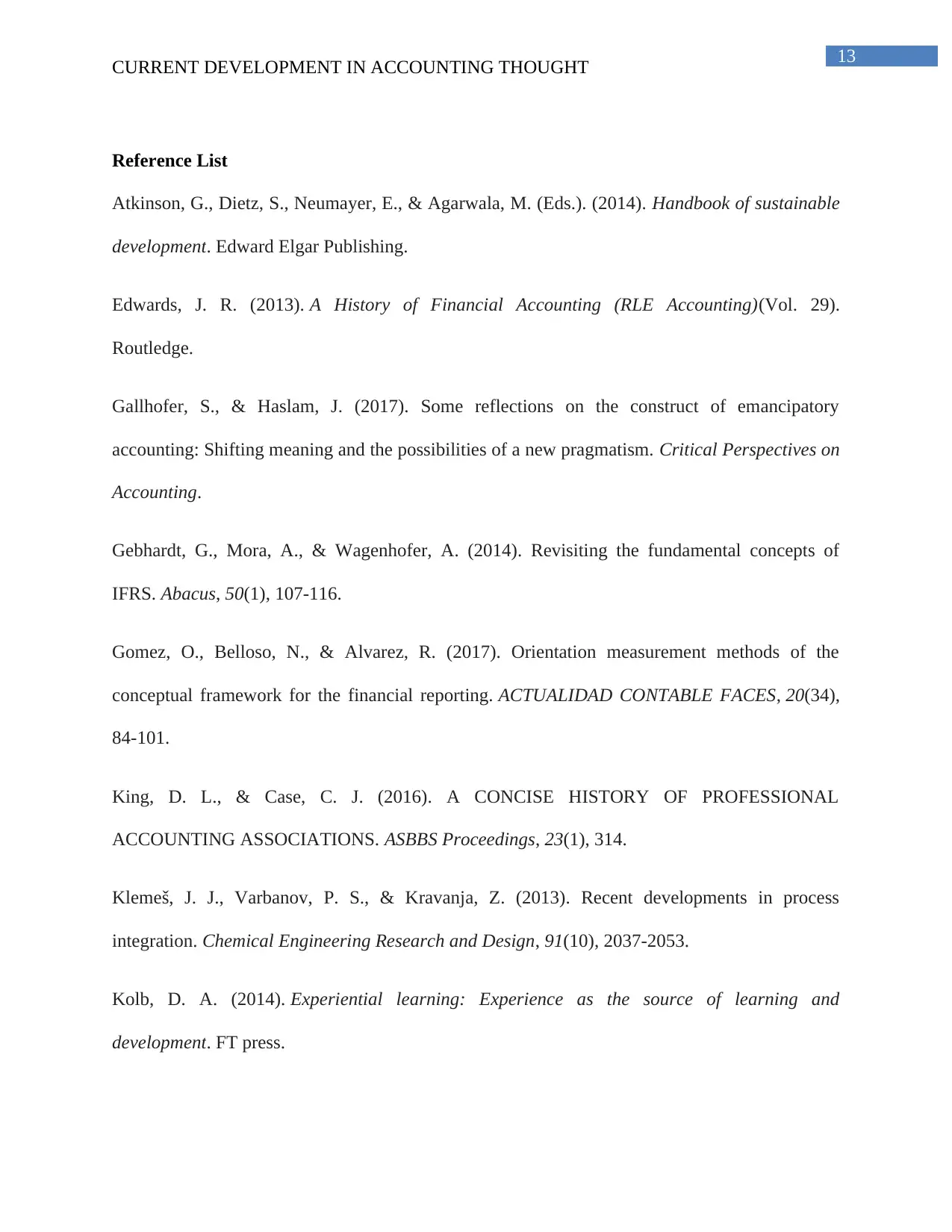
13
CURRENT DEVELOPMENT IN ACCOUNTING THOUGHT
Reference List
Atkinson, G., Dietz, S., Neumayer, E., & Agarwala, M. (Eds.). (2014). Handbook of sustainable
development. Edward Elgar Publishing.
Edwards, J. R. (2013). A History of Financial Accounting (RLE Accounting)(Vol. 29).
Routledge.
Gallhofer, S., & Haslam, J. (2017). Some reflections on the construct of emancipatory
accounting: Shifting meaning and the possibilities of a new pragmatism. Critical Perspectives on
Accounting.
Gebhardt, G., Mora, A., & Wagenhofer, A. (2014). Revisiting the fundamental concepts of
IFRS. Abacus, 50(1), 107-116.
Gomez, O., Belloso, N., & Alvarez, R. (2017). Orientation measurement methods of the
conceptual framework for the financial reporting. ACTUALIDAD CONTABLE FACES, 20(34),
84-101.
King, D. L., & Case, C. J. (2016). A CONCISE HISTORY OF PROFESSIONAL
ACCOUNTING ASSOCIATIONS. ASBBS Proceedings, 23(1), 314.
Klemeš, J. J., Varbanov, P. S., & Kravanja, Z. (2013). Recent developments in process
integration. Chemical Engineering Research and Design, 91(10), 2037-2053.
Kolb, D. A. (2014). Experiential learning: Experience as the source of learning and
development. FT press.
CURRENT DEVELOPMENT IN ACCOUNTING THOUGHT
Reference List
Atkinson, G., Dietz, S., Neumayer, E., & Agarwala, M. (Eds.). (2014). Handbook of sustainable
development. Edward Elgar Publishing.
Edwards, J. R. (2013). A History of Financial Accounting (RLE Accounting)(Vol. 29).
Routledge.
Gallhofer, S., & Haslam, J. (2017). Some reflections on the construct of emancipatory
accounting: Shifting meaning and the possibilities of a new pragmatism. Critical Perspectives on
Accounting.
Gebhardt, G., Mora, A., & Wagenhofer, A. (2014). Revisiting the fundamental concepts of
IFRS. Abacus, 50(1), 107-116.
Gomez, O., Belloso, N., & Alvarez, R. (2017). Orientation measurement methods of the
conceptual framework for the financial reporting. ACTUALIDAD CONTABLE FACES, 20(34),
84-101.
King, D. L., & Case, C. J. (2016). A CONCISE HISTORY OF PROFESSIONAL
ACCOUNTING ASSOCIATIONS. ASBBS Proceedings, 23(1), 314.
Klemeš, J. J., Varbanov, P. S., & Kravanja, Z. (2013). Recent developments in process
integration. Chemical Engineering Research and Design, 91(10), 2037-2053.
Kolb, D. A. (2014). Experiential learning: Experience as the source of learning and
development. FT press.
Paraphrase This Document
Need a fresh take? Get an instant paraphrase of this document with our AI Paraphraser
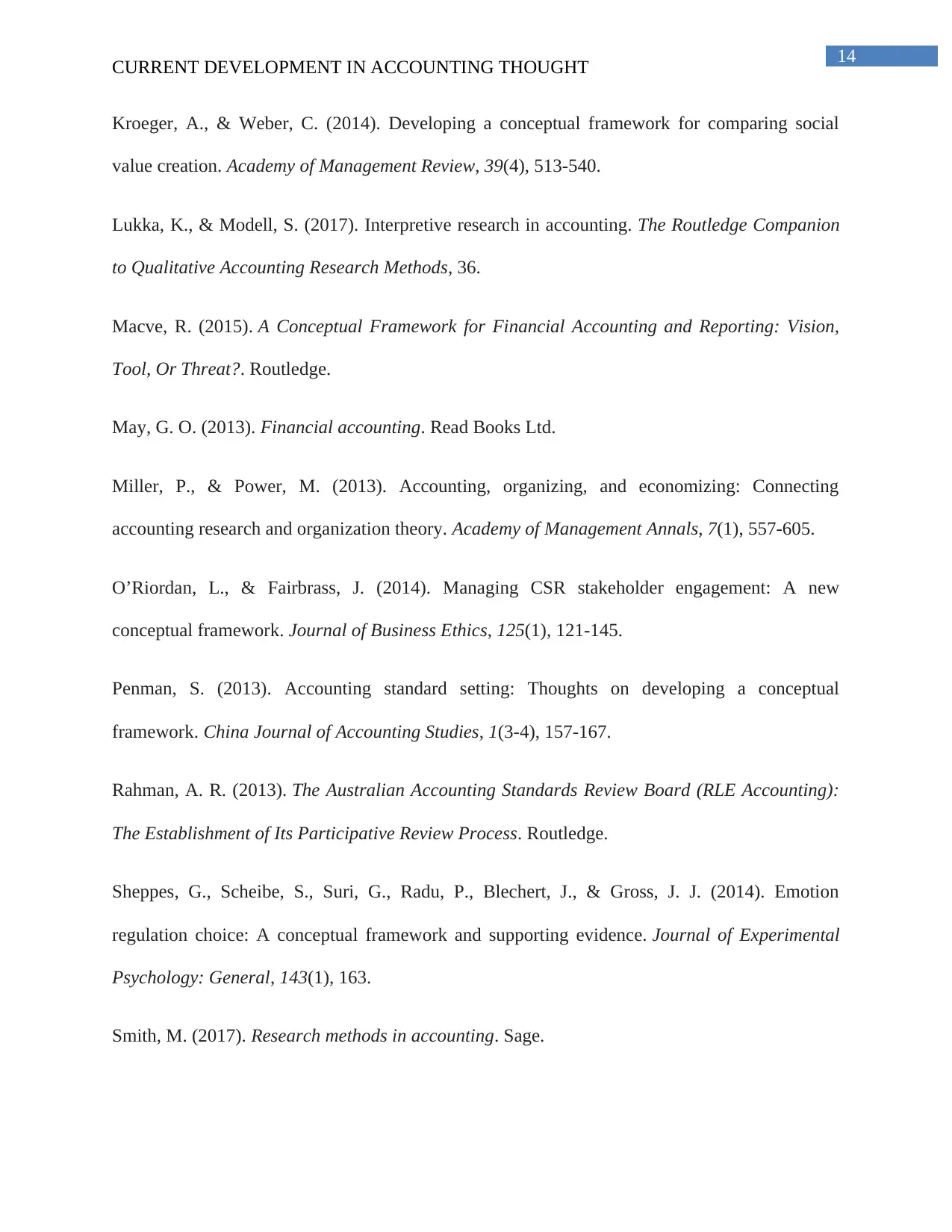
14
CURRENT DEVELOPMENT IN ACCOUNTING THOUGHT
Kroeger, A., & Weber, C. (2014). Developing a conceptual framework for comparing social
value creation. Academy of Management Review, 39(4), 513-540.
Lukka, K., & Modell, S. (2017). Interpretive research in accounting. The Routledge Companion
to Qualitative Accounting Research Methods, 36.
Macve, R. (2015). A Conceptual Framework for Financial Accounting and Reporting: Vision,
Tool, Or Threat?. Routledge.
May, G. O. (2013). Financial accounting. Read Books Ltd.
Miller, P., & Power, M. (2013). Accounting, organizing, and economizing: Connecting
accounting research and organization theory. Academy of Management Annals, 7(1), 557-605.
O’Riordan, L., & Fairbrass, J. (2014). Managing CSR stakeholder engagement: A new
conceptual framework. Journal of Business Ethics, 125(1), 121-145.
Penman, S. (2013). Accounting standard setting: Thoughts on developing a conceptual
framework. China Journal of Accounting Studies, 1(3-4), 157-167.
Rahman, A. R. (2013). The Australian Accounting Standards Review Board (RLE Accounting):
The Establishment of Its Participative Review Process. Routledge.
Sheppes, G., Scheibe, S., Suri, G., Radu, P., Blechert, J., & Gross, J. J. (2014). Emotion
regulation choice: A conceptual framework and supporting evidence. Journal of Experimental
Psychology: General, 143(1), 163.
Smith, M. (2017). Research methods in accounting. Sage.
CURRENT DEVELOPMENT IN ACCOUNTING THOUGHT
Kroeger, A., & Weber, C. (2014). Developing a conceptual framework for comparing social
value creation. Academy of Management Review, 39(4), 513-540.
Lukka, K., & Modell, S. (2017). Interpretive research in accounting. The Routledge Companion
to Qualitative Accounting Research Methods, 36.
Macve, R. (2015). A Conceptual Framework for Financial Accounting and Reporting: Vision,
Tool, Or Threat?. Routledge.
May, G. O. (2013). Financial accounting. Read Books Ltd.
Miller, P., & Power, M. (2013). Accounting, organizing, and economizing: Connecting
accounting research and organization theory. Academy of Management Annals, 7(1), 557-605.
O’Riordan, L., & Fairbrass, J. (2014). Managing CSR stakeholder engagement: A new
conceptual framework. Journal of Business Ethics, 125(1), 121-145.
Penman, S. (2013). Accounting standard setting: Thoughts on developing a conceptual
framework. China Journal of Accounting Studies, 1(3-4), 157-167.
Rahman, A. R. (2013). The Australian Accounting Standards Review Board (RLE Accounting):
The Establishment of Its Participative Review Process. Routledge.
Sheppes, G., Scheibe, S., Suri, G., Radu, P., Blechert, J., & Gross, J. J. (2014). Emotion
regulation choice: A conceptual framework and supporting evidence. Journal of Experimental
Psychology: General, 143(1), 163.
Smith, M. (2017). Research methods in accounting. Sage.
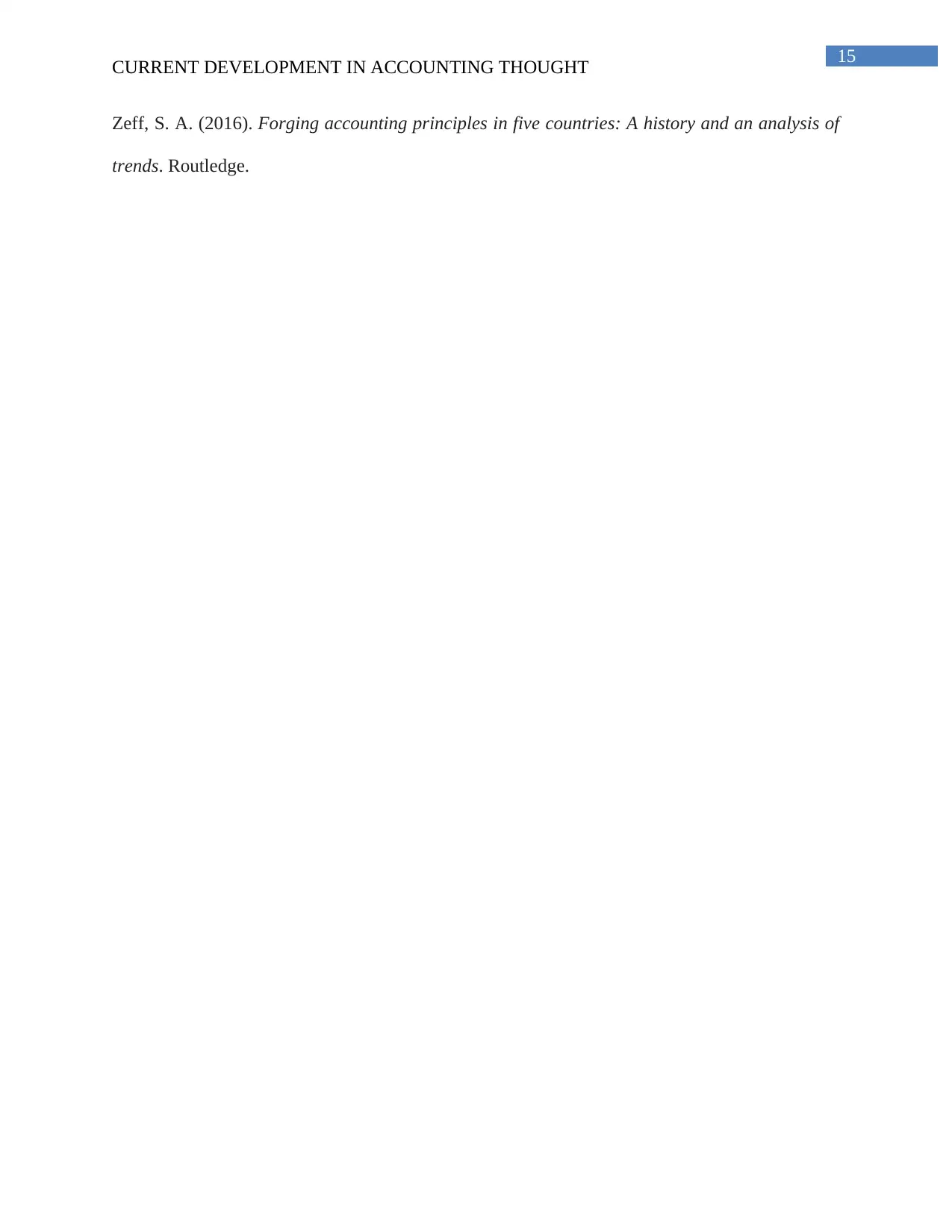
15
CURRENT DEVELOPMENT IN ACCOUNTING THOUGHT
Zeff, S. A. (2016). Forging accounting principles in five countries: A history and an analysis of
trends. Routledge.
CURRENT DEVELOPMENT IN ACCOUNTING THOUGHT
Zeff, S. A. (2016). Forging accounting principles in five countries: A history and an analysis of
trends. Routledge.
1 out of 15
Related Documents
Your All-in-One AI-Powered Toolkit for Academic Success.
+13062052269
info@desklib.com
Available 24*7 on WhatsApp / Email
![[object Object]](/_next/static/media/star-bottom.7253800d.svg)
Unlock your academic potential
© 2024 | Zucol Services PVT LTD | All rights reserved.





